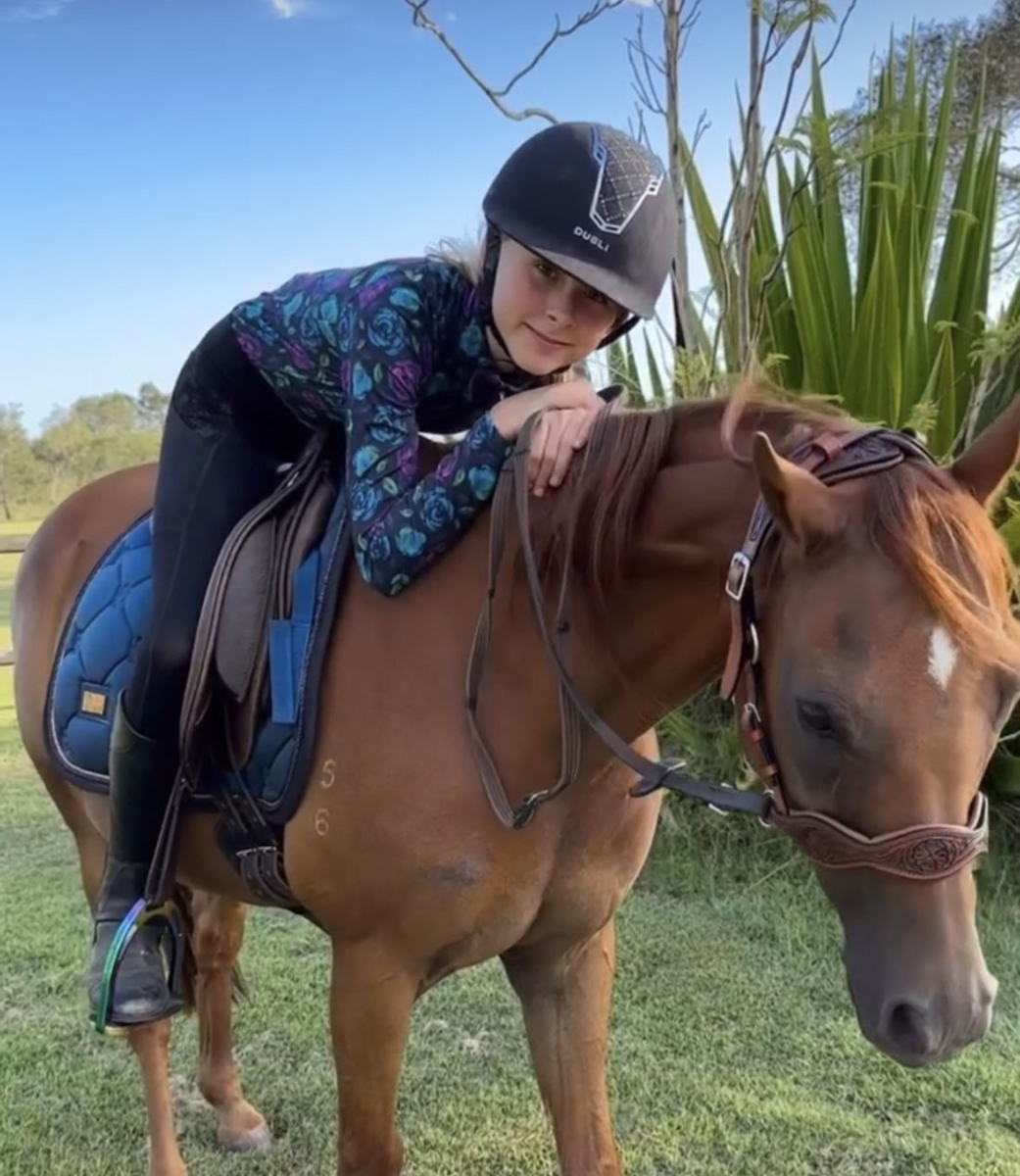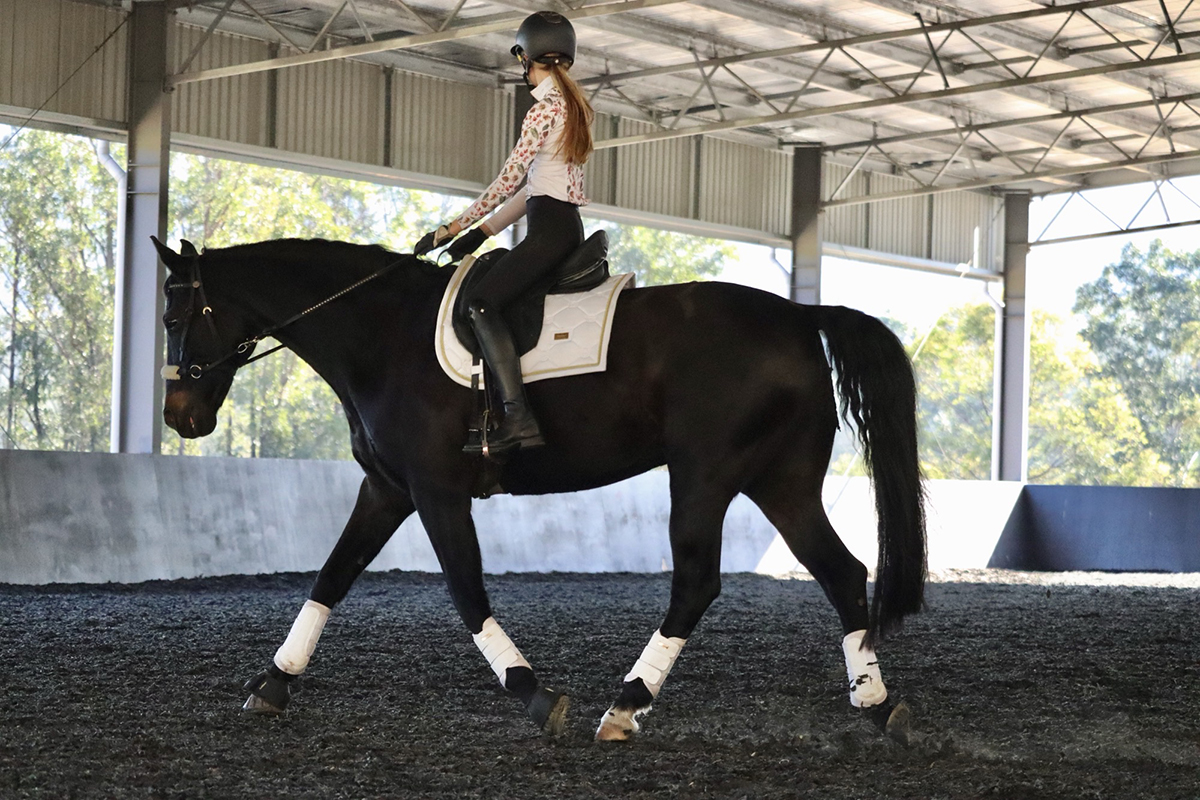When Bella Touzel encountered contact issues with her pony Buster, it led her to eventually transitioning him to a bitless bridle; he never looked back. Now, with the support of Pony Club Australia, Bella is continuing the bitless journey.
Bella Touzel was in the saddle from age four and off to Pony Club from the beginning with her first pony, Max. When the time came and she was ready to go it alone off the lead, Bella and her family began searching for a pony that would allow her to take that next step in her riding career.
“We began our search for a trusty little first ridden pony,” explains Bella. “We found Buster through word of mouth – he was never advertised – from a family in Queensland. The minute I met him there was an instant connection.” A week later, Buster and Bella were off to their first rally together at Grafton Pony Club.
“After a little while we noticed that Buster didn’t seem comfortable in his bit,” explains Bella. “At first, we thought he just needed his teeth done by the vet. This did not stop the problem, and the mouth opening, bit chomping and sad expression continued even though he was still willing to do all that was requested of him without fuss.”
“We couldn’t shake the feeling
that it didn’t seem right…”

As Bella explains, it was a learning process for her and her mother, Ashlee. “We were told by people that he was just fussing with the bit and not to worry, but we couldn’t shake the feeling that it didn’t seem right, that he wasn’t comfortable. So next, we booked a bit fitter. The lady came out and tried so many different bits and not a single one made any difference. We then had the vet out and we had X-rays done of his head, neck, back and legs and a full vet check to look for any pain or discomfort followed by multiple body workers.”
They found nothing obviously wrong with Buster and were left scratching their heads.
In seeking help with Buster’s contact issues, then 10-year-old Bella went to coach Wendy Bruszewski. An accredited EA Advanced Level Dressage Judge, FEI Level 2 Driving Judge and ANWE – Working Equitation Judge, Wendy had a background in classical dressage. She had trained with Portuguese trainer Rodrigo de Matos – who has visited Australia to coach for many years – and had also travelled to France and Portugal and spent time learning from people that work in classical training methods.
After trying a few different things with Buster, Wendy suggested they go bitless to break the cycle of bit issues. Bella was keen from the get-go to try. “I simply said to Mum, ‘He doesn’t like the bit, so I don’t want to use it anymore’.”
From that day on, Buster never had a bit in his mouth again. “He has been the happiest, most willing, trustworthy, incredible pony. Years of bitless riding followed for us! Everything from mustering cattle, to showjumping and sporting at Pony Club,” explains Bella.
PCA LEADS THE WAY
Pony Club Australia is one of the few Australian equestrian organisations that allows the use of bitless bridles in competition; this applied to all disciplines, and in both training and competition.
“In July 2022, Pony Club Australia introduced the National Gear Rules that now apply across the country,” explains PCA Participation & Development Manager Sally Wiseman. “Previously, gear rules were individualised by state. The gear committee was made up of a representative from each state, who met over two years, to come to an agreed national policy around gear. The National Gear Committee agreed to include bitless bridles with a more simple and automated exemption process. We implemented this to gauge the popularity of bitless bridles and to see what disciplines riders wanted to use them in. We allowed side-pull and crossover styles,” notes Sally.
“From July 2023, we updated the rules so that any rider could apply for an exemption to wear a bitless bridle in any discipline for both rally days and competition. We also extended the allowed bridles to include bitless bosal bridles,” says Sally, explaining that PCA doesn’t allow hackamore bitless bridles, or combination hackamores, due the excessive leverage they can force upon the horse.
In January 2024, PCA updated the rules so that anyone could ride bitless in a side-pull, crossover or bosal, without an exemption, to train or compete in any discipline. “We have since seen riders compete in dressage, jumping and eventing programs bitless. Some junior riders have also competed and placed in State Level competitions, such as show jumping, in their bitless bridles,” says Sally.
While PCA allows the use of bitless bridles, they are still not allowable in competition with many other organisations, including Equestrian Australia. “It’s a shame there is no option for bitless in Equestrian Australia competitions so we could have shown what is possible with bitless riding,” muses Bella. “We are so grateful for the support and encouragement from Grafton Pony Club and Pony Club Australia.”
SCHOOLMASTER ‘DAMON’

Buster is now semi-retired, with Bella moving on to bigger horses and ultimately following her budding passion for dressage. Of course, he remains a beloved part of the family. “After giving us so many wonderful years we can’t bear to part with him and will care for him for the rest of his days,” explains Bella.
In May this year, Bella’s family purchased Grand Prix schoolmaster Furst Dance MBE from Megan Bryant. Keen to continue the journey she started with Buster, Bella has also ridden ‘Damon’ in a bitless bridle.
“We began transitioning Damon to bitless riding only a few weeks ago. I developed such a passion for riding bitless thanks to Buster and I want to be able to ride all our horses bitless as much as possible.”
With careful and correct training in place already thanks to Megan, Bella says Damon has taken it all in his stride. “It’s going fantastic! It took Damon all of 20 minutes to adapt to the bitless bridle,” she explains, adding that he wears a crossover style bridle. “Damon is such a lovely trained horse that it was a quicker process than normal as his understanding of seat, leg and voice aids is so well established in him. I’m a very petite 14-year-old rider and Damon is a big powerful Warmblood, so it really goes to show that the bit is not needed at all if the right steps are taken in the training.”
TRAINING BITLESS

“The teaching ethos I share with Bella is that not all training is about having a connection to a bit,” explains Wendy. “Training involves learning many ways to develop the connection, including working from the ground ‘in-hand’, the skills you have or need to learn as a rider, and in how you will develop your relationship with your horse.
“Some time spent riding bitless is also valuable for Bella to develop her connection to her new horse and working on her body dynamics that are also interactive with the feels she needs to develop in this new relationship,” adds Wendy of the value in working Damon in the bitless bridle.
“Training and riding in the bitless bridle hasn’t really changed how I train,” notes Bella. “If anything, it’s helping me be a better rider. It’s teaching me that I really don’t require so much ‘hand’. That I can still have a balanced, harmonious and correct ride with self-carriage without a bit. It’s actually really exciting.”
Wendy says that working bitless is nothing new and in fact it comes back to a lot of classical dressage training principles.
“Classical training concepts involve work in hand in a cavesson and in most schools of equitation in Europe the rider is introduced, and the horse continues to work in hand. The horse is introduced to the bit after a certain level of training has been achieved and the trainer and rider work together to progress the development of self-carriage,” she explains.
“The classical concept is a transition from working bitless to training the connection to a bridle and bit. That is not the way many horses are trained today. Many training methods involve putting a bit on a young horse and letting it get used to it, some might even tie the horse’s head down! The horse might fight the bit and eventually accepts it but frequently many other issues evolve. Even the traditional cowboys used to ride the horse without a bridle and many use bosal and hackamores and still do. Some ranch horses may never feel a bit in their mouth.”

“I would really like
to be a part of the
bitless movement.”
“The pathway to becoming a competitive dressage rider involves learning many things. It’s unlikely we’ll see bitless being embraced for competing purposes, but reality is that a horse should be able to work easily in self-carriage and it’s not the bit that is the key component of achieving and developing that element of the training, although it is part of it.”
Of course, neither Bella nor Wendy are under any illusion that transitioning to bitless is the answer to every problem for every horse. The correct use of a bitless bridle comes as part of a broader training philosophy and any piece of equipment is only as good as the fit and the hands that are using it. In the wrong hands, bitless bridles – depending on the design – still have the potential to inflict substantial noseband pressure and it’s therefore important that the lack of bit isn’t replaced with a stronger hand.
For Bella, going bitless has taught her quite the opposite: she now replies less on her hands, and focuses more on her connection with the horse through her seat and legs. Each and every horse is different; in allowing bitless bridles in competition as PCA has, it provides riders with the option to use equipment that their horses is happiest in. And that’s what’s important.
NEXT BIT OF THE JOURNEY
“My goals with Damon moving forward are to continue to learn from the vast experience he has to offer. I feel incredibly lucky to have this special horse to continue on my dressage journey,” says Bella.
With a focus now on EA-level dressage, Bella and Damon are yet to compete bitless as it’s not allowed – however, the upcoming Pony Club NSW State Dressage Championships will provide them with the opportunity to ride bitless in front of judges.
Sally notes that PCA did have a 16-year-old rider who competed at the 2023 Queensland State Showjumping Championships bitless and placed in her class, however as far as she knows nobody has done a State Dressage Championship bitless. “We looking forward to following her journey and highlighting it to encourage more riders,” says Sally, adding that there’s been a movement of not only current members trying bitless options, but also new members joining due to the option of competing bitless in their chosen discipline.
“I would really like to be a part of the bitless movement,” says Bella. “I want to compete my horse in official dressage competition bit-free and I want to show that he can do all the things required in the higher-level tests without a bit. I want to help change the rules to allow bitless bridles in competition here in Australia and to help others learn how to transition to bitless bridles.”
You can follow Bella and Damon’s journey on Instagram via @bella_does_dressage.
This Pony Club article was brought to you by Scoot Boot; Australian-designed hoof boots for pleasure, performance and rehabilitation. Click here to find out more about the Scoot Boot range.EQ

